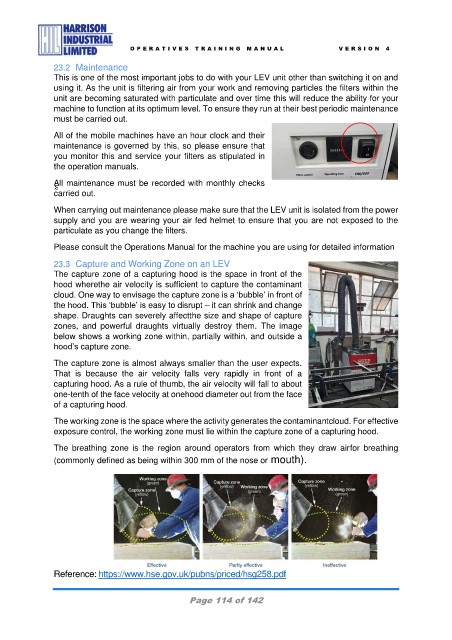Page 115 - HIL Operatives Training Manual V4 16022024_Neat
P. 115
O P E R A T I V E S T R A I N I N G M A N U A L V E R S I O N 4
23.2 Maintenance
This is one of the most important jobs to do with your LEV unit other than switching it on and
using it. As the unit is filtering air from your work and removing particles the filters within the
unit are becoming saturated with particulate and over time this will reduce the ability for your
machine to function at its optimum level. To ensure they run at their best periodic maintenance
must be carried out.
All of the mobile machines have an hour clock and their
maintenance is governed by this, so please ensure that
you monitor this and service your filters as stipulated in
the operation manuals.
All maintenance must be recorded with monthly checks
s
carried out.
When carrying out maintenance please make sure that the LEV unit is isolated from the power
supply and you are wearing your air fed helmet to ensure that you are not exposed to the
particulate as you change the filters.
Please consult the Operations Manual for the machine you are using for detailed information
23.3 Capture and Working Zone on an LEV
The capture zone of a capturing hood is the space in front of the
t
hood where he air velocity is sufficient to capture the contaminant
cloud. One way to envisage the capture zone is a ‘bubble’ in front of
the hood. This ‘bubble’ is easy to disrupt – it can shrink and change
t
shape. Draughts can severely affect he size and shape of capture
zones, and powerful draughts virtually destroy them. The image
below shows a working zone within, partially within, and outside a
hood’s capture zone.
The capture zone is almost always smaller than the user expects.
That is because the air velocity falls very rapidly in front of a
capturing hood. As a rule of thumb, the air velocity will fall to about
one-tenth of the face velocity at one hood diameter out from the face
of a capturing hood.
The working zone is the space where the activity generates the contaminant cloud. For effective
exposure control, the working zone must lie within the capture zone of a capturing hood.
The breathing zone is the region around operators from which they draw air for breathing
(commonly defined as being within 300 mm of the nose or mouth).
Reference: https://www.hse.gov.uk/pubns/priced/hsg258.pdf
Page 114 of 142

